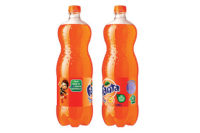Inks and graphics offer connections, experiences
Beverage brands use innovations to stand out on the shelf




Special effects, one-to-one personalized printed, or freshness graphics and temperature indicators on bottles and cans help brands make customer connections. Inks and coatings are at the heart of any sensory packaging experience, according to experts.
“Color and feel are two significant ways inks can have an impact on beverage containers for both the brand owner and the consumer,” says Dave Waller, vice president of sales rigid packaging, INX International Ink Co., Schaumburg, Ill.
“INX offers a full product line of inks and coatings, including inks for 2-piece cans and monobloc containers such as aluminum bottles,” Waller says. “We offer conventional, ultraviolet and specialty products. Special-effect inks include thermochromatic, fluorescent and glow-in-the-dark.”
Standing out requires bold color while also being environmentally sound without making an impact on production.
“The full product portfolio offers vivid color retention, retort and fabrication properties, while demonstrating low formaldehyde and zero haps to remain environmentally friendly,” Waller adds.
The processing speed matters, too. Applying inks and coatings to cans is a dry offset process that is different. As many as 2,300 cans are printed and “varnish is applied wet-on-wet over the inks,” Waller says.
Major brands in beer, soft drinks and energy drinks use inks from INX and partner Chromatic Technologies Inc. (CTI), Colorado Springs, Colo., according to the company.
The sensory experience matters, says Pat Edson, chief marketing officer for CTI.
“Brands are focused on creating in-hand ‘experiences and theater’ with their packaging,” Edson says. “Any specialty inks that can do that are highly sought after.”
CTI ink technology helps brands convey messaging, indicate hot or cold temperatures or create extensions of the product’s brand. CTI chemistry offers photochromic, black light, glow-in-the-dark, social media activation and security protection.
Additionally, the company recently announced advances in chemistry that offer a much wider color spectrum beyond “blue” ink.
Customers desire many options for photochromic and thermochromic ink colors in today’s marketplace. Ink that reacts to different temperatures, complemented by a broad range of colors, improves brand and unit differentiation.
In line with this, High Velocity Ink (HVI) thermochromic ink delivery system used with CTI’s newly expanded color palette options ensures inks can be applied efficiently at high speeds and are durable against heat and sunlight. CTI’s photochromic inks, or sunlight-activated inks, have fast kinetics, broad color options and durability as well. Its reveal inks allow a brand to share messages or promotion codes.
But printing on any packaging – metal, cardboard, paper, pressure-sensitive labels, shrink sleeves and plastic – requires a “partner who can provide the technical support for the diverse set of packaging suppliers printing on those substrates,” Edson says.
Connecting ink chemistry with mobile and digital interaction is the future, Edson says. “It is not available yet, but a lot of work is being done in this arena [driven by brands].”
Ball Corp.’s Graphic Center of Excellence (BCOE) is a graphics pilot line that, in conjunction with its graphics department, allows the Broomfield, Colo.-based company to do cutting edge testing of graphics with customers around the world.
“The BCOE is where customers go to set standards for commercial can runs,” says Jared Brody, marketing and innovation manager at Ball Corp. “[The line] allows customers to see what cans look like and make small changes in real time to color and texture.”
The company’s experience with aluminum packaging material helped it develop its ink portfolio, Brody says.
“Ball has been making cans for decades and continues to work toward innovative inks and coatings as well as applications,” he says. “Over that time, Ball has developed processes with the goal of ensuring we deliver the highest quality can or aluminum bottle possible to our customers.” The company is using everything from brighter colors and variable graphics to matte coatings to differentiate its brands in a very competitive marketplace, Brody adds.
Ball focuses on creating packaging that exceeds customers’ expectations from the pilot line ink to its GCOE, but also creates and follows the highest standards in printing, Brody says.
Eyeris high-definition printing can deliver near-photo-quality images and Dynamark technology offers 12 different graphics on the package as well as temperature-activated thermochromic inks that change color.
“If a customer wants to communicate quality ingredients, designing a graphic using our Eyeris high definition graphics that produces near photo quality images, would ensure the superior ingredient story stands out to consumers,” Brody says.
“Our goal is to provide innovative solutions that not only help our customers’ brands to stand out, but also enhance their brands by enhancing the overall consumer sensory experience with the package,” he says.
Advances in the color, design and even texture take years of research and development, according to inks and coating experts. Cross-industry partnerships and pilot programs continue to support development of the inks and coatings of the future.
Looking for a reprint of this article?
From high-res PDFs to custom plaques, order your copy today!










